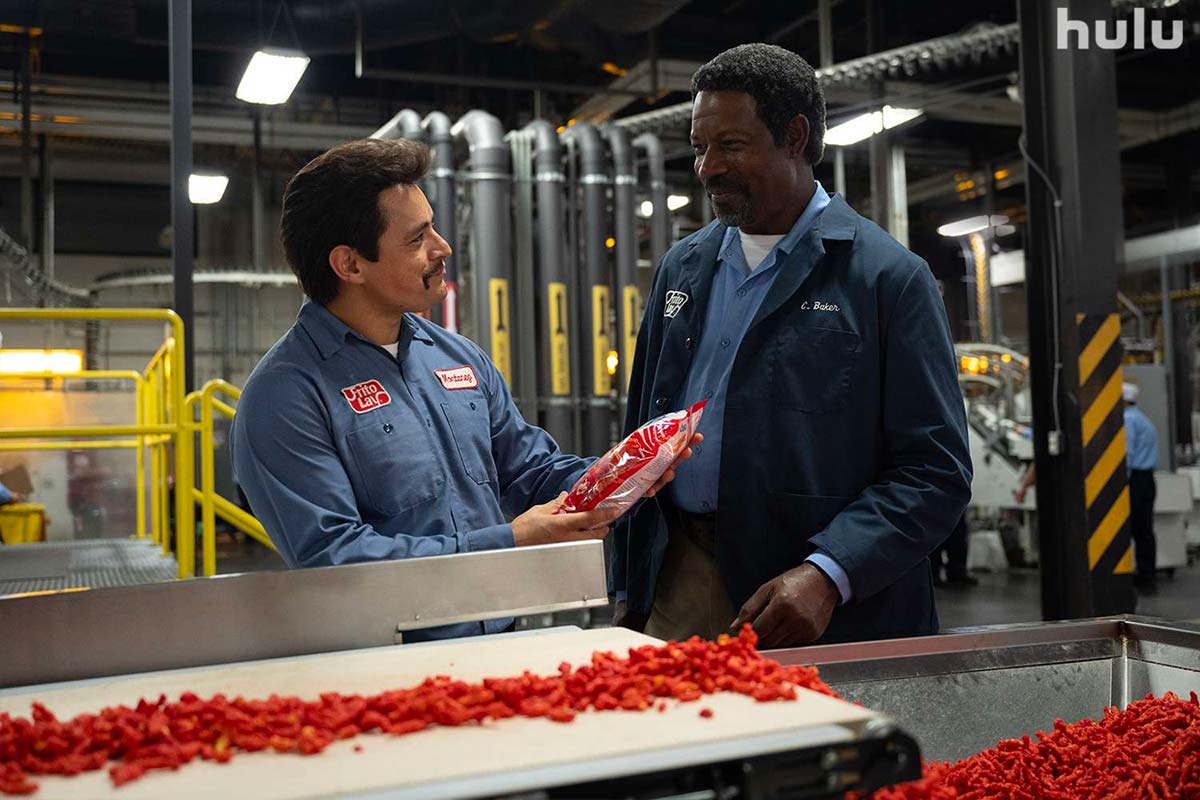Google the origins of Flamin’ Hot Cheetos, and one can quickly fall down a rabbit hole of half-truths and urban legends. The popular story – the one now cemented in film history – says that the brand of Cheetos was initially conceived by maintenance worker Richard Montañez. But thanks to the uplifting version of events presented in Eva Longoria’s “Flamin’ Hot,” the real-life events take a back seat to the positive representation of Mexican American culture onscreen.
READ MORE: SXSW 2023 Preview: 25 Must-See Film & TV Projects To Watch
Even before the 1990s, Richard Montañez (Jesse Garcia) had never been afraid of a little hard work. As a child, he would sell his mother’s tortillas to the other kids at school, claiming to have done more to introduce a generation of Californians to Mexican food than Taco Bell. But after years of skirting the law with his wife Judy (Annie Gonzalez) – taking whatever less-than-legal work he could find without a college diploma or even a high school degree – Richard decides to get his life in order. He convinces a friend to put in a good word and secures a maintenance role at the local Frito-Lay factory.

Things are good – for a while. Richard wins the hearts of his coworkers and even learns more about the manufacturing equipment from Clarence (Dennis Haysbert), a well-respected engineer passed over for promotions for over a decade. But when Reagan’s vision for America hits the 1980s like a brick, Richard struggles to hang onto what little work he has. It is then that inspiration strikes: the employees who work on the factory floor represent the biggest untapped demographic for the company. If Richard and Judy can find a way to introduce a little bit of Mexican spices to the product line, they might just save the jobs of everyone at the company.
For her feature film directorial debut, television icon Eva Longoria breaks out a full bag of narrative tricks. Garcia’s Montañez proves to be a cheerfully unreliable narrator, often embellishing important moments of his life before doubling back closer to the truth. Longoria also plays with structure as a director, introducing fantasy sequences that combine comedy with lessons about racism. These comedic flourishes seem like a natural evolution of Longoria’s work in sitcoms, seeking out moments of visual comedy and not relying only on dialogue for humor.
For example, in one key scene, the camera pans the factory floor of Frito-Lay, with each new piece of equipment stamped and dated with the slow progression of years. In another scene, a young Richard is confronted by the police, and the film switches to a three-camera black-and-white sitcom depiction of what might have happened had Richard been white. These may not be the most innovative choices, but with many other biopics refusing even the whiff of subjectivity, they sure as hell are interesting ones.
In a weaker movie, these kinds of comedic embellishments might feel like a distraction. But both Garcia and Gonzalez are too charismatic to be denied. Each sequence acts in service of the semiserious-but-uplifting nature of the story. Longoria has described “Flamin’ Hot” as primarily a love story. She’s right: the relationship between Richard and Judy – how they lean on each to unlearn the violent and racist communities they grew up in – is the real highlight of the movie. As a couple, they sidestep the Point A or Point B scripting of most rags-to-riches stories. They are neither defined nor limited by their class, and “Flamin’ Hot” feels no need to editorialize their happiness.

But as the film moves beyond this relationship and into the mechanics of the spicy Frito-Lay revolution, “Flamin’ Hot” does cede some moral high ground. Hollywood has gotten very good at clucking its tongue about capitalism to serve its own purposes, so it is odd to see even those token attempts at criticism absent from the movie. Tony Shaloub offers us perhaps cinema’s most benevolent CEO, and the movie’s resolution – where Frito-Lay reaps the rewards of the Flamin’ Hot formula – seems like a muted victory at best. For a film so well-versed in the trials of navigating systemic racism, it is more than a little strange that the only thing that really changes for Frito-Lay is the product line.
Then again, “Flamin’ Hot” has little interest in being a Soderbergh film. This is a movie centered on communities – religious, ethnic, and commercial – and how determined people can break free from the boxes that society has built around them. “Flamin’ Hot” may come across as a little conventional about the paths we take in pursuit of the American dream, but its heart lies in its celebration of Mexican American culture. And thanks to the unwavering chemistry between Garcia and Gonzalez, the movie has a pretty sizable margin for error.
Still, our original question remains. Does “Flamin’ Hot” owe audiences a historically accurate version of the truth? No film – not even the most dogmatic of documentaries – can present history without making editorial choices in how they structure people and places. What Longoria has created is less a history lesson and more a fairy tale that reframes an American success story within California’s Hispanic community. You may doubt its accuracy, but the message will resonate, and that is a far more interesting conversation than how closely “Flamin’ Hot” matches the Montañez Wikipedia. [B]
Follow along for all our reviews and coverage of the 2023 SXSW Film & Television Festival.





